Newsletter Spring 2020

This winter needs needs no explanations. Incessant rain, snow and storm force winds, particularly throughout February which is known anyway as the ‘hungry month’ for being the most difficult month of the year for animals living out, especially wildlife.
We fared better than many as being situated on high ground any flooding was temporary, though the land in general was so saturated that we had to close most of the fields to the donkeys and ponies, not only for their own safety but to ensure the grass was sufficiently protected it could grow again later in the year.
Even in a country as lush with vegetation as Ireland, any animal left unprotected and without supplementary feeding would surely have perished this winter – with the possible exception of Shetland ponies and some of the native pony breeds who seem to be able to survive on a minimal food supply . . . as long as they didn’t get stuck in mud somewhere.
As a consequence we now have many more animals in care than we would normally accept but when the choice is ‘do or let die’ we have to act, though unfortunately we have been unable to help several people hoping to rehome their donkeys due to difficult circumstances, or because they were not coping with the weather. For this we apologise but the welfare cases must be prioritised. For the well being of the animals already in our care we have to stay within the limitations of our facilities and manpower and they are stretched to the limit and beyond!
In terms of storm damage we conclude we have a VERY active Guardian Angel looking after the place as we only had one big tree fall, quietly and secretly one afternoon between storms. With its roots depleted from continual bashing by the wind and the land saturated, its top heavy canopy finally caused it to topple – to within feet of a building but doing no damage beyond breaking a few minor branches off other trees during its majestic descent. We consider ourselves extremely lucky!
SO LONG OLD FRIEND ROKI

Although it had been expected for some weeks we were still sad to say goodbye to dear Roki, a very aged spotted/white donkey gelding who died peacefully at the sanctuary early in the winter.
Roki had been blind for the last 12 months and poorly sighted for about two years prior to that, but had always managed to find his way around familiar surroundings and enjoyed a good quality of life until the last few days, when it was obvious he was stressed and unhappy. It was time to let him go.
Roki had always been a loner where other animals were concerned but enjoyed the summer visitors, especially those with ginger biscuits, apples or carrots. He was a kind, gentlemanly donkey, adored by all.
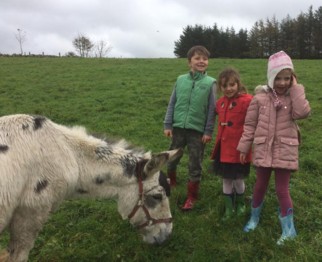
Right: Roki wearing his head protector made for him by Deborah and Sasha Hutnik
Left: His last young visitors
We feel privileged to have been his carers for a number of years and thank his previous owner, Carol, for putting her trust in us to look after him and for keeping in touch over the years.
Our WELFARE WORK has been dominated by two major cases; abandoned equines in Drumcong Forest, Co. Leitrim and a separate case concerning eleven neglected donkeys.
DRUMCONG:
MAPLE and OAKLEY
This situation goes back to June 2018 when we received our first call about a pony mare in dire trouble. Regular readers of our newsletters may remember the story of Maple, a severely dehydrated and very lame skewbald mare who had been spotted by people living in the area. The weather at the time was extremely hot and dry so, not wishing to trespass, they provided water at the entrance to the forest, not realising that Maple was too sore to walk the distance to reach it. Once they saw that she was deteriorating further an emergency call sent our welfare people dashing to her rescue.
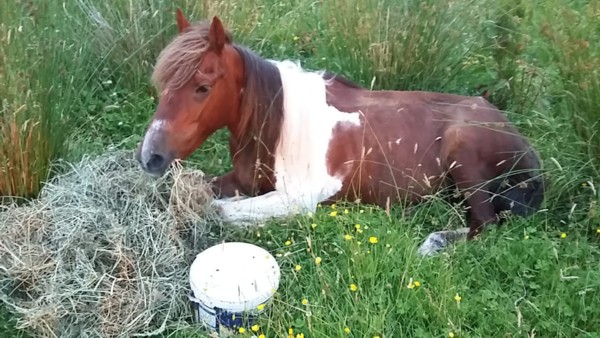
With great difficulty they persuaded her to walk the short distance to the horse trailer where she was given small amounts of water until strong enough to walk onto the trailer.
(There is a short video on our Facebook page).
Once home she rested for 2 days before offering to stand up again, yet miraculously, within two months she had blossomed into a beautiful pony.
She needed attention from the farrier, the dentist and the chiropractor but was soon cantering round the field in the best of form. Her hooves are permanently damaged and will need constant care throughout the rest of her life – thank you as always to our marvellous farrier Brian Horohoe and his team.
Initially we thought Maple was a ‘one-off ’ but instinct kept pulling the welfare people back to check the site and sure enough several more horses were discovered in varying degrees of compromise. These were confiscated by the Pound where most have since found forever homes in loving situations but only after months of care and rehabilitation. Over the next months several horses came and went and three more recent carcasses were found in different parts of the forest including a black mare we had hoped to collect on the next visit.
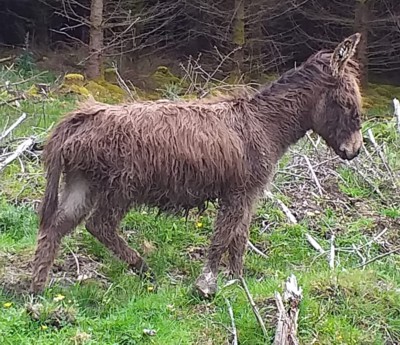 Then came little Oakley, a tiny colt donkey (Autumn 2019 Newsletter) abandoned without his mother – or indeed any other company as far as we could find.
Then came little Oakley, a tiny colt donkey (Autumn 2019 Newsletter) abandoned without his mother – or indeed any other company as far as we could find.
He was wet, cold, very thin and timid so again it took a few hours of patient negotiation with him before he could be caught, loaded and brought home to the Sanctuary where his recovery was slow and anguished for us all.
Later, when he was stronger, our vet was able to geld him and he chose to live with the older mares and geldings until recently.
He is confident now and will mix with all sizes of donkey and pony though he remains tiny, not much bigger than the average yearling foal. In fact, Verity, born to Dawn last May, now towers above him!
By this time many more animals had been found struggling for survival and we had involved other more influential departments to investigate. Although most animals were not microchipped some had microchips registered to breeders in other parts of the country suggesting a possible ‘ring’, possibly dealers buying in unspecified groups of mixed equines, taking out any saleable animals and dumping the rest. In order to help the animals a low profile was essential.
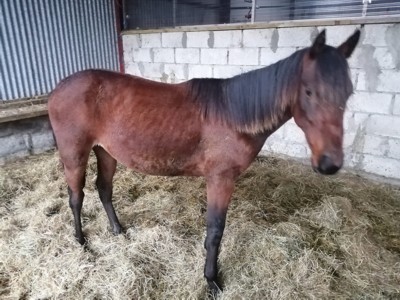
HICKORY and SPRUCE
Next to come to us as extreme welfare cases were Hickory and Spruce (again Autumn 2019 Newsletter), Hickory as an emaciated yearling colt pony who was wearing a full set of well worn shoes suggesting use as a trotter in a gig or sulky.
He was very sick pony indeed, severely dehydrated, in part due to a constant, evil smelling diarrhea which after many veterinary tests proved to be a case of Rumen Fluke, common enough in cattle but rare in equines.
Right Hickory recovering well
As equines do not have a rumen the fluke had attacked Hickory’s duodenum causing permanent damage. Although under control now he will always need careful monitoring of his food intake yet despite his difficulties he has grown into a fun loving, affectionate pony.
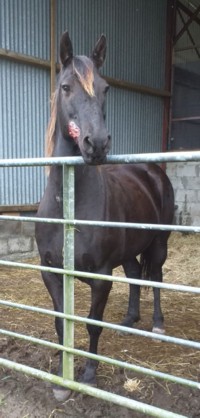
Spruce was found in good condition but with a hand sized wound on the side of his face which even after almost 7 months is not fully healed. He also had several body based sarcoids which were removed at Somerton Equine Hospital, all of which have healed beautifully with the exception of one which he managed to tear open on wire (we think!) so that is taking longer.
It is thought his face wound is the result of someone trying to remove a sarcoid with a caustic substance. The skin appears to be growing back though we doubt the coat will regrow, yet despite his battle scarred body he is a magnificent looking boy of c. 14.2hh with a kind and curious temperament.
Spruce was microchipped when he arrived but with a barcode that was not familiar to us. With help from Leisure Horse Ireland he was eventually identified to have been passported as a non pedigree through the New Forest Pony Society, UK. His colour was given as black and his age at 12 years, his origin thought to be from Ireland!
We are currently in the process of trying to obtain a duplicate passport for him if his original owners cannot be traced.
Right: Spruce showing his wound
CEDAR
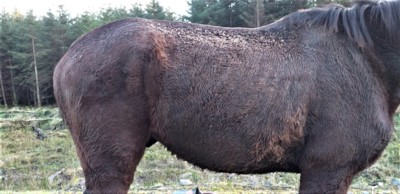 A further check up in the forest one afternoon by our stalwart welfare officers revealed Cedar, a 15.2hh thoroughbred gelding, stuck in a boghole.
A further check up in the forest one afternoon by our stalwart welfare officers revealed Cedar, a 15.2hh thoroughbred gelding, stuck in a boghole.
He was already exhausted so it took a couple of hours to manhandle him free. Exhausted, wet and weak he couldn’t be left overnight without risk to his life so the officers decided there was no choice but to make the 70kms return journey with the horse box before he staggered back into one of the many adjacent bog holes.
Above: Cold and thin
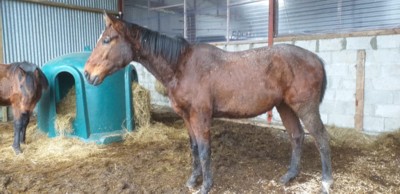
At this stage it was already dark so it was with trepidation they returned, wondering if he would have fallen again or wandered off back into the forest but, clever boy! – he had walked to the entrance barricade and was waiting patiently for his rescuers where he loaded with little persuasion.
Right: Cedar in improved condition sharing a barn and enjoying some hay with Hickory.
The next day our vet confirmed he was ‘a walking skeleton with severe rainscald’. We all presumed he was a really old horse judging by the huge hollows over his eyes and the sunken back and wobbly legs but a look in his mouth aged him at only 4-5 years old.
Sure enough, as he recovered, the hollows filled out, his back straightened, his legs became strong again and his beautiful gentle character shone through. His tail has either been cut short or has been chewed off by another horse. He has not been injured as far as we can tell so we expect it will grow again throughout the summer. We hope to find him a loving forever foster home where he will have all the love and attention he craves.
What we hope will be our last event at Drumcong involved a very similar situation which, sadly, had an unhappy outcome.
PLEASE NOTE - More photos of this story are shown on an extra page . . . Click Here ![]()
WARNING! some people may find them distressing
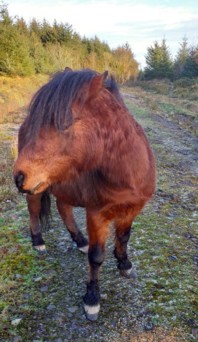
Our two welfare officers, the County Leitrim Animal Welfare Warden and the welfare officer from the ISPCA had agreed to meet for a final look around and found to their horror, a severely emaciated white pony mare stuck in another bog hole on the opposite side of the forest from where Cedar was found. Once again everyone was up to their thighs in mud in a desperate attempt to free her but she was already too weak to help herself, and as one end was freed the other sank back in.
After two hours she was finally lifted free (machinery was not an option because of the location) but it was another two hours before the first of several vets contacted was able to reach them, by which time it was obvious she was dying and the only kind option was to help her on her way.
The little mare was full of sarcoids but our welfare officers had none-the-less spent weeks befriending her in the hopes we could bring her to the Sanctuary for a few weeks of tender loving care, even if, inevitably, she had to be put to sleep because of this condition. They were heartbroken that the story should end so badly.
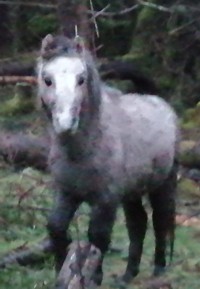
The ISPCA had agreed to take her but instead took two other youngsters, barely more than foals, who were also found wandering about and are, to our knowledge, the last of the animals still in the forest. (We will continue to check). At least they are safe and with a hopeful future.
Dozens of people have contacted us to register their disbelief than any ‘human’ being can be so consistently callous but sadly this is only one of many cases throughout the country, some even worse. The bottom line always seems to be money, a difficult mindset to change.
ELEVEN LITTLE DONKEYS
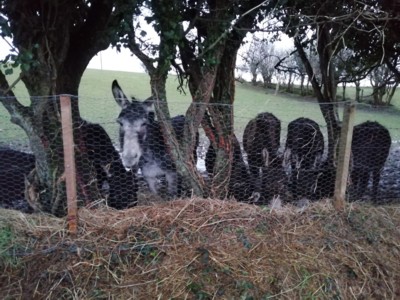
The second welfare case involved eleven small dark brown donkeys kept together on a saturated four acre field without food or shelter throughout one of the wettest winters on record, a real trial for animals created for arid, desert life and without the protection of a waterproof coat.
The field was on quite a steep hillside with a large pond at the top. It ran down to the roadside which was bordered by a high bank on which hawthorn bushes grew, providing some meagre shelter but requiring the donkeys to stand in a waterlogged ditch to avail of it.
There were four stallions, one still only about eighteen months old, five mares and two foals, one filly and one colt, both born late last Autumn and therefore only a few months old. The mother of the colt foal is already noticeably pregnant again.
Above: The only available shelter
Below: a bleak situation
Our resources were already so stretched we were reluctant to bring in eleven more donkeys so contacted the District Veterinary Officer of the Department of Agriculture, Food and the Marine for assistance, gladly given when he saw the condition of the animals.
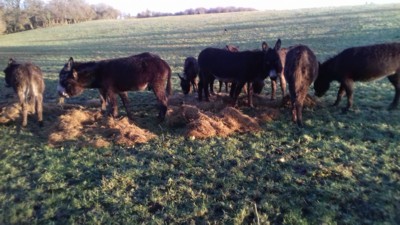
Initially the owner was asked to relinquish the four stallions to us but only after all the donkeys had their hooves trimmed and were treated for lice, wormed and microchipped.
They were also to be given food daily. None of this happened immediately so we continued to take hay to them every day until the owner bought fodder and started to deliver it himself, and even then we took them extra as we felt he was not giving them enough.
More weeks passed until we were able to collect the little boys whom we kept for a while to try and build them up for the journey to The Donkey Sanctuary in Mallow, Co Cork, who had agreed to castrate them in their hospital at no expense to ourselves. All we had to do was cover the transport.
When they arrived the veterinary staff there were so horrified at their condition they immediately transferred them to a ‘cosy’ house where they were kept on deep straw with a heat lamp and 24 hour monitoring, a situation which continued for five weeks until they felt they were strong enough to undergo the gelding operation.
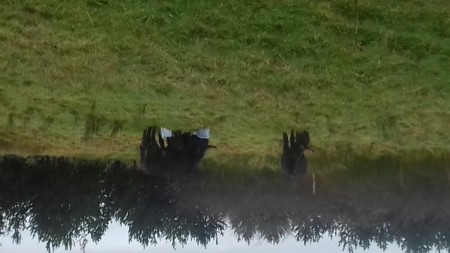
Meanwhile we hit some of the worst weather of the winter in early February with one storm following another, sleet, snow and bitter temperatures.
It was obvious that without further intervention the five mares and their tiny offspring would perish and it was without hesitation the DVO gave permission for us to bring them into the Sanctuary where we did our best to replicate the comfort received by the colts and stallions at The Donkey Sanctuary. They were all pitifully thin apart from the mare who is heavily pregnant again.
BODY CONDITION IN WINTER
With the thick woolly winter coat common to donkeys it is not always possible to determine their weight until you can get your hands into the fur and feel the bones sticking through but most of these were SO thin it was obvious on sight, especially the poor little mare who was still suckling the young filly foal.
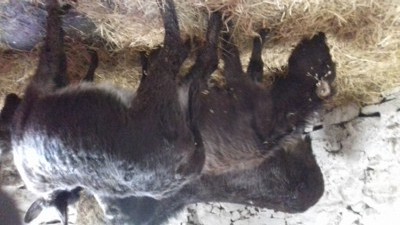
They were all plastered with mud up to the knees and hocks, which as it dried and began to come away, tore some of the skin with it. Rain scald covered their backs and heads, especially around their noses and ears. This has dried rock hard and scabby so it is only as they begin to change their coats in the summer that we expect it to fall away. Certainly brushing it out is not an option as their skin is far too sore.
Right: Notice the backbone of the mare on the right of the
photo which is visible even through her thick winter coat.
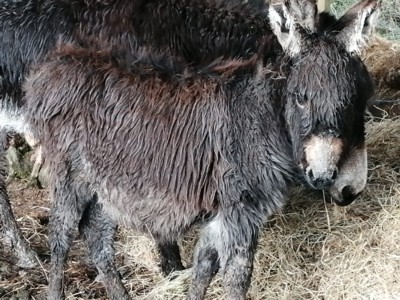
Left: The colt foal, bigger and stronger than the filly foal
Taking them on has challenged our facilities and resources and created a great deal of extra work on an already overloaded schedule but none of us regret the decision for a moment.
For several days they remained in their stable, mostly resting on deep straw, picking ad lib on good quality hay and being fed a small handful of Cool and Cooked muesli grain twice a day.
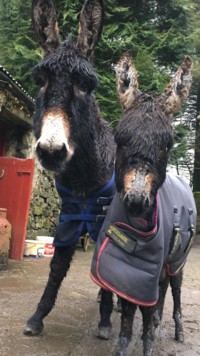
Despite the very wet weather they were dehydrated, possibly because their water trough was moated by water and mud so they were reluctant to use it. We found suitable waterproof padded rugs for the mares and bought two new ones for the tiny foals, as even our smallest rug in stock was far too big.
Thus clothed we gave them the option to wander out into the yard for exercise, only to learn they had had enough of outdoors and much preferred to stay where they were thank you! Gradually they did begin to explore, the little ones looking for all the world as if they were wearing knickerbockers with their woolly upper legs and skinny lower legs completely devoid of fur which had fallen out as the mud rubbed off.
Right: The little filly foal with her Mum taking their first exploratory steps outside.
Below:
The colt foal newly rugged up and enjoying the heat lamp.
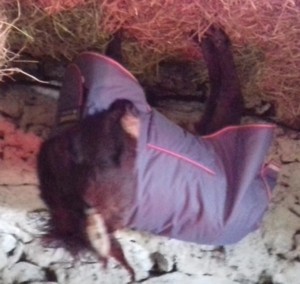
Although they had had their hooves ‘trimmed’ we were not happy with the outcome as they were all rocking as they walked and some were obviously sore, especially the mother of the filly foal who had to be helped to her feet in the mornings for the first two weeks after arrival.
Our farrier kindly spent some time with them, correcting the balance and showing us where incorrect trimming had created bruising and corns – just as painful for them as for us! Two of the mares showed signs of laminitis which was definitely not from overfeeding, so the cause was most likely stress, exacerbated by the extreme softening of the hooves due to standing constantly in wet conditions.
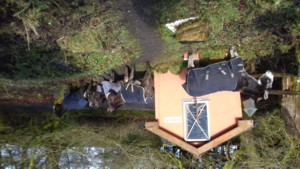
One mare’s back hooves were so soft and spongy it was possible to feel the pedal bone through the sole of the hoof so Brian bandaged them up with a mixture of iodine and sugar which would help to draw out excess moisture and harden the hooves. Following a second treatment the hooves were already much improved and benefited further from a miraculous break in the weather which gave us two whole DRY days!
It has to be remembered that a donkey’s hoof is designed to cope with arid desert conditions and should be hard and tough enough to allow them to walk 20-30kms a day in search of food. They do need a certain amount of moisture but certainly not the excess they habitually receive in Ireland.
They are all doing well now though have a long way to go to regain a ‘normal’ weight. We are supposed to return them to their owner in the Summer but the jury is out on that decision until a suitable shelter and area of hardstanding has been provided and the use of more land has been determined. A donkey is one ‘livestock unit’ ie one animal per acre is considered the optimum for grazing purposes. Hence a four acre field can only support four donkeys—not eleven! Although the owner is willing for us to keep the colt foal and geldings that still leaves six others including five pregnant mares. Discussions are in order!
The real tragedy of this case is that even now the owner does not seem to grasp the distress and suffering he has bestowed upon these little creatures. For those of us close to animals it beggars belief that anyone can look at such a situation and think it is all right. We don’t believe he is a bad person, just insensitive and ill-informed . . .and tight with the purse strings. So we prepare for an uphill struggle . . .
ALTERNATIVE CHRISTMAS TREE
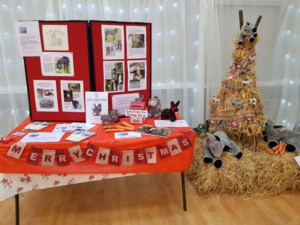
Just before Christmas Gail Green and her family created an ‘Alternative Christmas Tree’ of straw, decorated with handmade and hand painted donkey decorations in order to attend a festival at Easkey, where they hoped to raise awareness of our work.
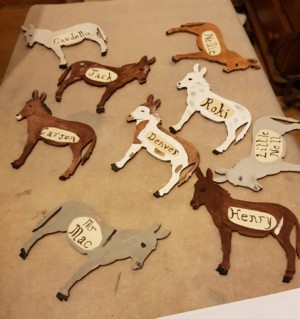
Sadly, due to the remote venue, atrocious weather and bad signing the event was poorly attended.
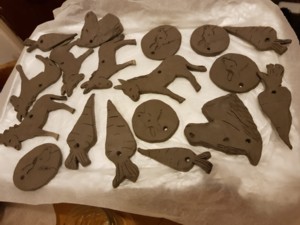
So not wishing to let all that creativity go to waste, we hung the decorations in the donkey barn and enjoyed them ourselves over the festive season.
Everyone loves a tryer—thank you Gail!
ONGOING NEWS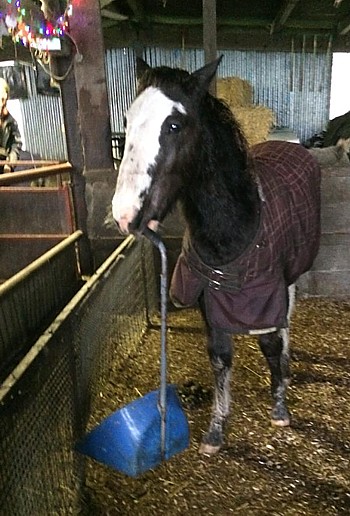
TULO
No decision has been reached on Tulo, a very large donkey brought in last Autumn with a mass of sarcoids on his genitals. We suspect these growths are inoperable but want to have a thorough investigation before making a final decision to euthanase him. For this we need a sterile place in the sheds and some mild, dry weather before the flies arrive, neither of which are possible just now. As soon as the weather improves we will do our very best for him.
SARACEN
Born to Shantil last July, continues to grow almost while we watch. He is already bigger than most of his playmates but is a kind, gentle boy, easy to handle and with a mischievous sense of humour. He loves to steal our mucking out tools!
Right: Saracen the tool thief!
DISTRESSING IMAGES on the extra page
Dozens of people have contacted us to register their disbelief that any ‘human’ being can be so consistently callous but sadly this is only one of many cases throughout the country, some even worse. The bottom line always seems to be money, a difficult mindset to change.
If you have looked at these photos we thank you for your courage. They show the mare as she was found and the subsequent struggle to free her. Tragically, exhaustion took its toll. She was already so weakened by starvation and her underlying problem (most likely cancer) that there was no hope for her and the best kindness anyone could offer was to put her to sleep. It was a harrowing day for all concerned.
By sharing these photos we are not looking for ‘a pat on the back’ - only to raise awareness of the despicable cruelty that is going on right here, right now. Not in some third world country but here in Ireland, one of the richest and supposedly best educated countries in Europe! Shame on us.
FOREVER GRATEFUL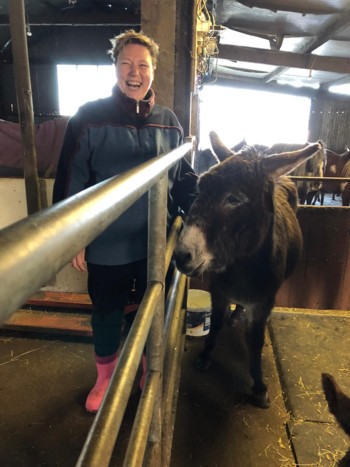
As always we have many people to thank for their support and help in a variety of ways from financial to practical, all of which is essential to keep us afloat and optimise the work we try to accomplish.
Huge thanks go again to Hartmud and Eli Krinitz who collected just shy of €4000 from their slide shows of Ireland shown in different venues in Switzerland and their native Germany. Hartmud has now retired from a long career as a professional landscape photographer with hundreds of slides shows and several beautiful coffee table books to his name and we are immeasurably grateful to him and Eli for the thousands of euros they have raised for us over many years.
They are true friends, both to us personally, and to the Sanctuary and we look forward to their future visits when they will not be under pressure to rise before dawn to maybe, just maybe, catch that special sunrise over the cairns of Carrowkeel.
Right: Janine with Henry
Thanks go to another German born lady Janine Feldmann who donated €100 of hay early in the winter, along with other donations; to the lady who sent €170 to us through her/our farrier; to the German people who sent €2000 anonymously into our Bank Account ‘to help with the work’; to South African Antjie Henn who organised an online raffle; to both Sean and Des who offered generous amounts of silage/straw or hay should we need it; to Ray Hardin, fosterer of Shanbo donkey, for a generous load of hay; to Kenneth and Aisling Togher for €300 in lieu of wedding favours (congratulations!); to the Irish College of English for €2000 and Wilma Heim for continuing to send her annual bonus from her business in Galway.
We thank volunteer helpers The Green family, Neil and Rebecca who look after most of our welfare calls and transport of animals; Saturday Sasha, Geraldine, Lorraine and Issy who both joined us on work experience/placement; to John and Evelyn who helped in many practical ways from clearing roadways and laying new gravel, to cleaning chimneys and roofs to making a new timber door for one of our sheds and many more jobs along the way; to Colm Williams who looks after the maintenance of our tractor and construction work on a professional level but never fails to weld a bit here or fix a door hinge there whenever he comes; to Dane for spreading the manure on our difficult land . . . and to many, many more who help to keep the wheels turning smoothly through each year.
Thanks must also go to the huge number of people who support us with donations without whom none of the work would even be possible. If some of you have not received a personal thanks I apologise as sometimes a card or donation arrives with just a Christian name, which could be one of several people, so please, if you would like a response, do include your surname and/or address. Thank you.
We hope you have enjoyed reading this newsletter, even though some of it may be repetitive to regular readers.
We wish you all a wonderful summer.
Sathya Sai Sanctuary Trust,, Castlebaldwin, Co. Sligo, Ireland F52 H046
Email: sai.donkeys@gmail.com. Tel: 00353 (0)861031932
Charity No CHY 10840 Registration 20028350
IBAN IE83BOF90528011954931 BIC Code BOFIIE2D